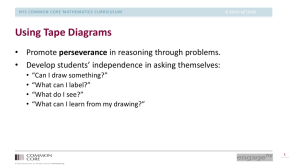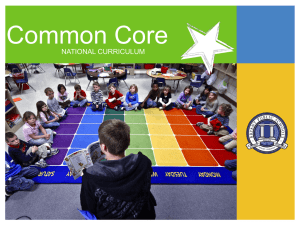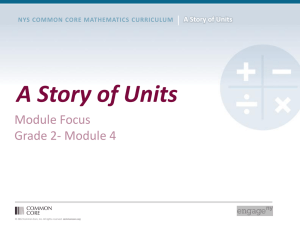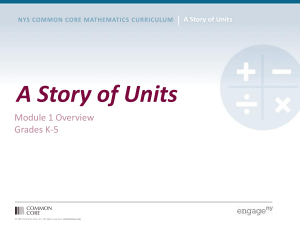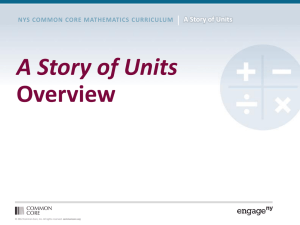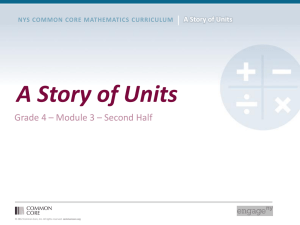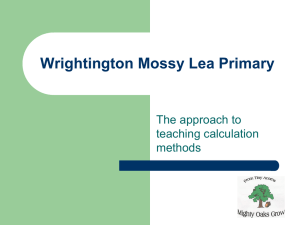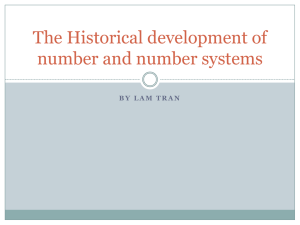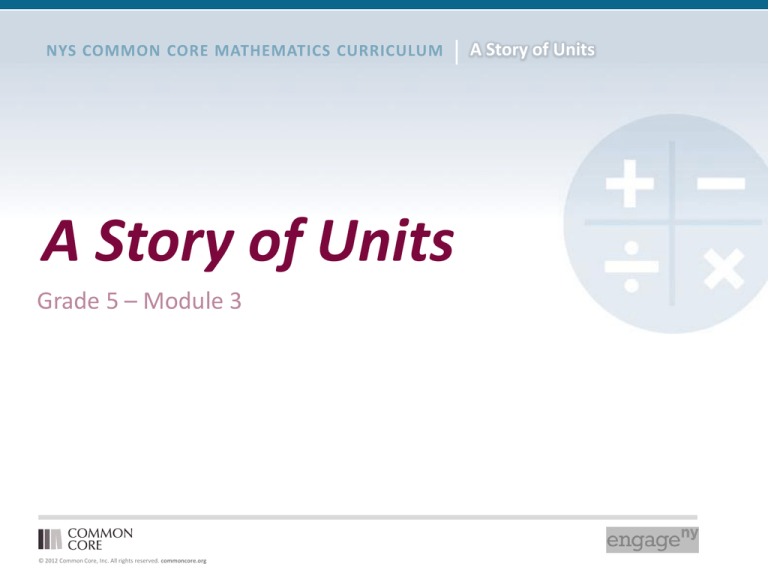
A Story of Units
A Story of Units
Grade 5 – Module 3
© 2012 Common Core, Inc. All rights reserved. commoncore.org
A Story of Units
Session Objectives
• Examine the development of mathematical
understanding across Grade 5 Module 3: Addition and
Subtraction of Fractions.
• Explore specific lessons to support planning.
• Review key mathematical models and instructional
strategies to support student understanding.
© 2012 Common Core, Inc. All rights reserved. commoncore.org
A Story of Units
Curriculum Overview of A Story of Units
© 2012 Common Core, Inc. All rights reserved. commoncore.org
A Story of Units
Agenda
Module 3 Overview
Lesson Study – Demonstration and Practice
• Lessons 1 & 2
• Lessons 3, 4, 6, & 7
• Lessons 8, 9, 11, & 15
Module Review
© 2012 Common Core, Inc. All rights reserved. commoncore.org
A Story of Units
Module Overview
Students extend their
understanding of fraction
equivalence and whole
number addition and
subtraction to add and
subtract fractions.
Page i.
© 2012 Common Core, Inc. All rights reserved. commoncore.org
A Story of Units
Topic A: Equivalent Fractions
4.NF.1, 4.NF.3c, 4.NF.3d
Lesson 1 Objective:
Make equivalent fractions with the
number line, the area model, and
numbers.
1
= =
2
Lesson 1, CD, Problem 1, Page 3.A.4.
© 2012 Common Core, Inc. All rights reserved. commoncore.org
A Story of Units
Topic A Demonstration: Lesson 1
5
4
=
Lesson 1, CD, Problem 4, Page 3.A.6.
© 2012 Common Core, Inc. All rights reserved. commoncore.org
A Story of Units
Topic A Practice: Lesson 2
Lesson 2 Objective: Make equivalent fractions with
sums of fractions with like denominators.
• Browse the CD.
• Study Problem 5, on page 3.A.21.
Lesson 2, CD, Problem 5.
© 2012 Common Core, Inc. All rights reserved. commoncore.org
A Story of Units
Topic A Debrief
• How does using the number line as a tool support
understanding of fraction equivalence?
• How many fractions share the same
point on a number line?
Lessons 2 Debriefs, page 3.A.22.
© 2012 Common Core, Inc. All rights reserved. commoncore.org
A Story of Units
Topic B: Making Units Pictorially
Lesson 3 Objective:
Add fractions with unlike units using
the strategy of creating equivalent
fractions.
1
3
1
2
+ =
Lesson 3, CD, Problem 2, 3.B.7.
© 2012 Common Core, Inc. All rights reserved. commoncore.org
A Story of Units
Topic B Demonstration: Lesson 3
2 2
+
5 3
6 10
=
+
15 15
=
16
15
=
1
1
15
Lesson 3, CD, Problem 4, 3.B.9.
© 2012 Common Core, Inc. All rights reserved. commoncore.org
A Story of Units
Topic B Study: Lesson 4
Lesson 4 Objective:
Add fractions with sums between 1 and 2.
• Browse through Lesson 4.
• Study the student work on page 3.B.25:
Problem 1:
2
3
1
2
+ =
Lessons 4, Problem Set, Question 1, Student Work
© 2012 Common Core, Inc. All rights reserved. commoncore.org
A Story of Units
Lesson 4: Debrief
L4 Objective: Add fractions with sums between 1 and 2.
•
•
•
•
How is L4 different from L3?
What model was used to solve this problem? How was it helpful?
What process was used to rename 7 sixths?
Would you use these same questions with fifth grade students?
Lesson 4, Student Debrief, Question 1, 3.B.25.
© 2012 Common Core, Inc. All rights reserved. commoncore.org
A Story of Units
Topic B Study: Lesson 6
Lesson 6 Objective:
Subtract fractions from numbers
between 1 and 2.
• Browse through Lesson 6.
• Study CD, Problem 1 on page 3.B.48 :
1
1
3
1
2
− =
Lessons 6, Concept Development, Problem 1
© 2012 Common Core, Inc. All rights reserved. commoncore.org
A Story of Units
Lesson 6: Debrief
L6 Objective: Subtract fractions from numbers between 1 and 2.
• How are these two solutions the same? Different?
Lesson 6, Student Debrief, Problem 1, 3.B.48.
© 2012 Common Core, Inc. All rights reserved. commoncore.org
A Story of Units
Topic B Problem-Solving Practice: Lesson 7
L7 Objective: Solve two-step word problems.
Shelby bought a 2 ounce tube of blue paint.
𝟐
𝟑
She used ounce to paint the water,
𝟑
𝟓
ounce to paint the sky, and some to paint a
flag. After that she has
𝟐
𝟏𝟓
ounce left. How
much paint did Shelby use to paint her flag?
Solve before you look.
Lesson 7, CD, Problem 3, Page 3.B.62.
© 2012 Common Core, Inc. All rights reserved. commoncore.org
A Story of Units
Topic B Problem-Solving Practice: Lesson 7
Lesson 7, CD, Problem 3, Page 3.B.62.
© 2012 Common Core, Inc. All rights reserved. commoncore.org
A Story of Units
Topic C: Making Like Units Numerically
Topic C: Making Like Units Numerically
Lesson 8 Objective:
Add fractions to and subtract fractions from
whole numbers using equivalence and the
number line as strategies.
3
1+1 =
4
Lesson 8, Concept Development, Problem 1, Page 3.C.5.
© 2012 Common Core, Inc. All rights reserved. commoncore.org
A Story of Units
Topic C Demonstration: Lesson 8
2
3−1
3
2
= 3−1 −
3
2
=2−
3
1
=1
3
Lesson 8, Concept Development, Problem 5, Page 3.C.8.
© 2012 Common Core, Inc. All rights reserved. commoncore.org
A Story of Units
Topic C Study: Lesson 9
Lesson 9 Objective:
Add fractions making like units numerically.
• Browse through Lesson 9.
• Study CD, Problem 4 on page 3.C.21 :
2
3
1
4
1
2
+ + =
Lesson 9, CD, Problem 4, page 3.C.21.
© 2012 Common Core, Inc. All rights reserved. commoncore.org
A Story of Units
Participant Practice: Lesson 9 Debrief
L9 objective: Add fractions making like units numerically.
• What patterns have you observed while finding
common units?
• What strategies can students use
to find common multiples?
Lesson 9, Student Debrief of CD, Problem 4, page 3.C.21
© 2012 Common Core, Inc. All rights reserved. commoncore.org
A Story of Units
Topic C Study: Lesson 11
Lesson 11 objective:
Subtract fractions making like units numerically.
• Browse through Lesson 11.
• Study CD, Problem 4 on page 3.C.50 :
3
3
5
−
1
2
2
=
Lesson 11, CD, Problem 4, page 3.C.50.
© 2012 Common Core, Inc. All rights reserved. commoncore.org
A Story of Units
Participant Practice: Lesson 11 Debrief
L11 Objective: Subtract fractions making like units numerically.
• How are these three solutions alike? Different?
Lesson 11, Student Debrief CD, Problem 4, page 3.C.50.
© 2012 Common Core, Inc. All rights reserved. commoncore.org
A Story of Units
Topic D: Problem-Solving Practice, Lesson 15
Topic D: Further Applications
Lesson 15 Objective: Solve multi-step word problems; assess
reasonableness of solutions using benchmark numbers.
Gavin had 20 minutes to do a three3
problem quiz. He spent 9 minutes on
4
4
question 1, and 3 minutes on question 2.
5
How much time did he have left for
question 3? Write the answer in minutes
and seconds..
Solve before you look.
Lesson 15, CD, Problem 4, Page 3.D.34.
© 2012 Common Core, Inc. All rights reserved. commoncore.org
A Story of Units
Topic D Problem-Solving Practice: Lesson 15
Lesson 15, CD, Problem 4, Page 3.D.34.
© 2012 Common Core, Inc. All rights reserved. commoncore.org
A Story of Units
Summary of Module 3
Topic A: Equivalent Fractions
Topic B: Making Like Units Pictorially
Topic C: Making Like Units Numerically
Topic D: Further Applications
26
© 2012 Common Core, Inc. All rights reserved. commoncore.org
A Story of Units
Biggest Takeaways
Turn and Talk:
• What’s one big idea in this module?
• How does this module progress from
concrete to representational to
abstract?
• What tools are used to enhance and
ensure students’ understandings?
© 2012 Common Core, Inc. All rights reserved. commoncore.org
A Story of Units
Biggest Takeaways: Possible Answers
What’s one big idea in this module?
Like units are needed in order to add and subtract. This is exactly the same as
whole numbers: ones with ones, tens with tens, halves with halves.
How does this module progress from concrete pictorial abstract?
Students folded paper to concretely find like units. Then they drew rectangular
models that looked just like the folded paper. Teachers were always recording
work. Eventually students were taught how to work abstractly with numbers
only. The concepts were applied in story problems.
What tools are used to enhance and ensure students’ understandings?
The module incorporates pieces of paper for folding, number lines, rectangular
models and tape diagrams.
© 2012 Common Core, Inc. All rights reserved. commoncore.org

